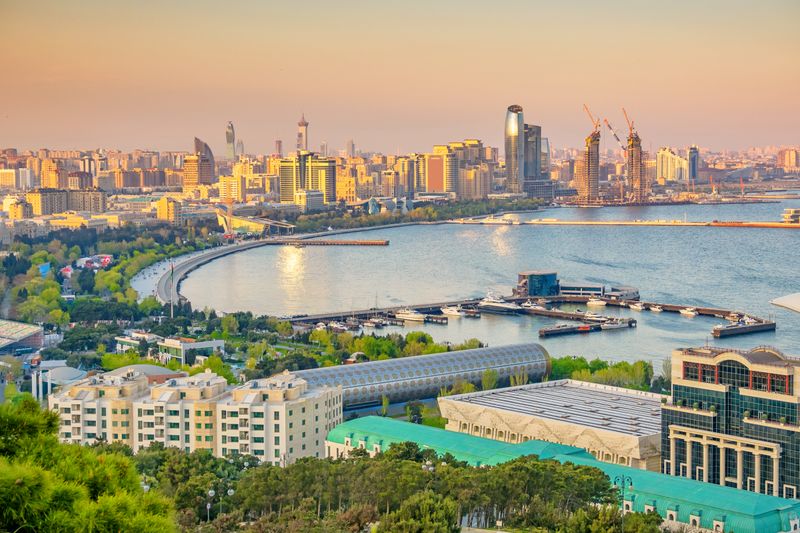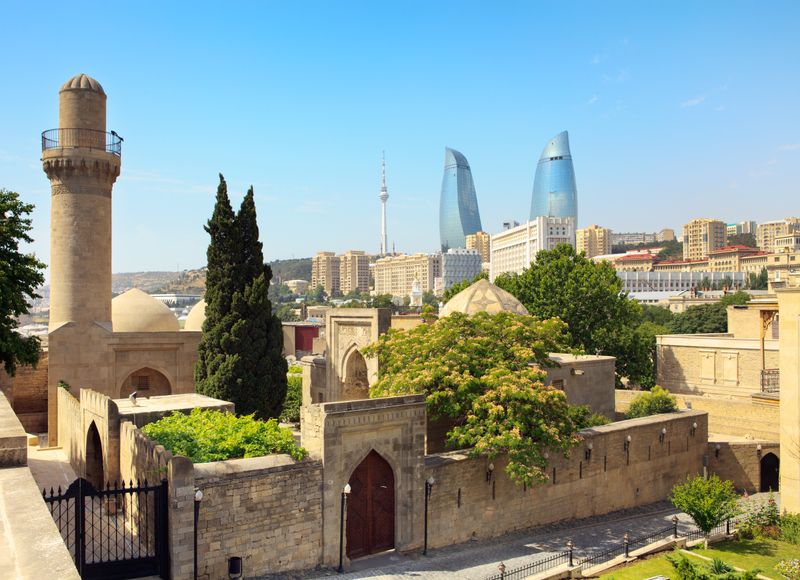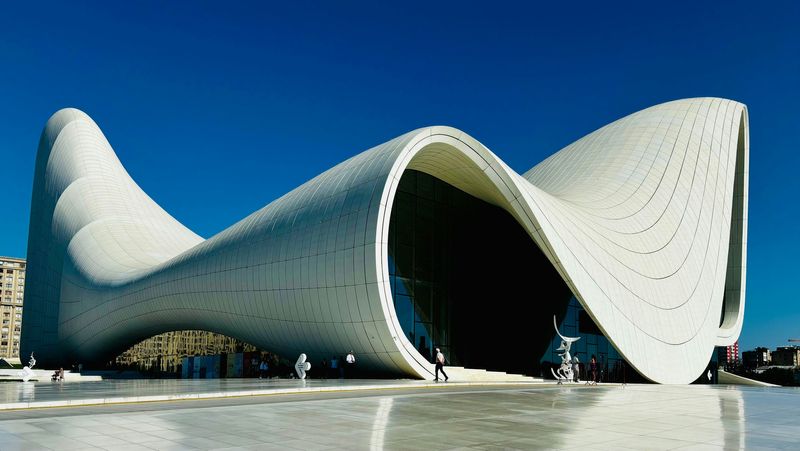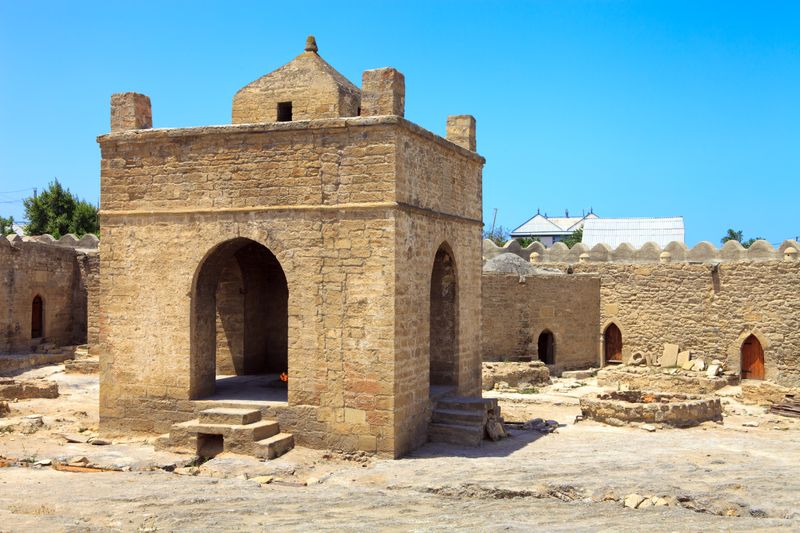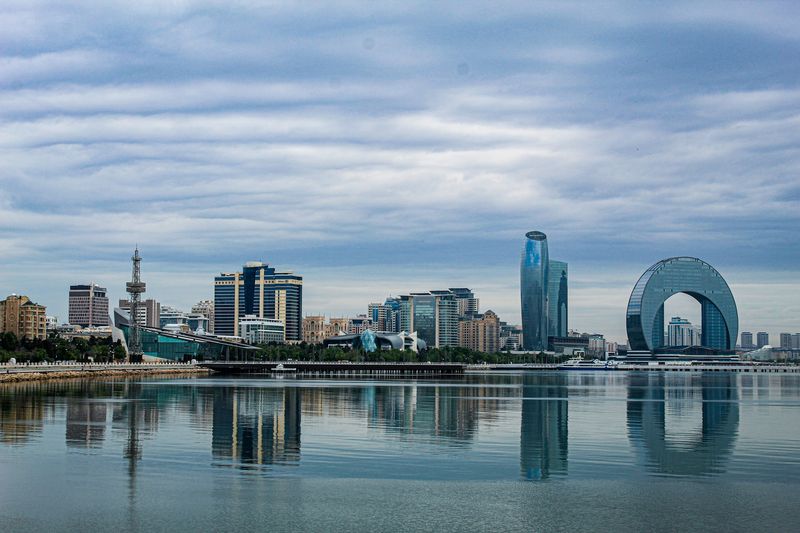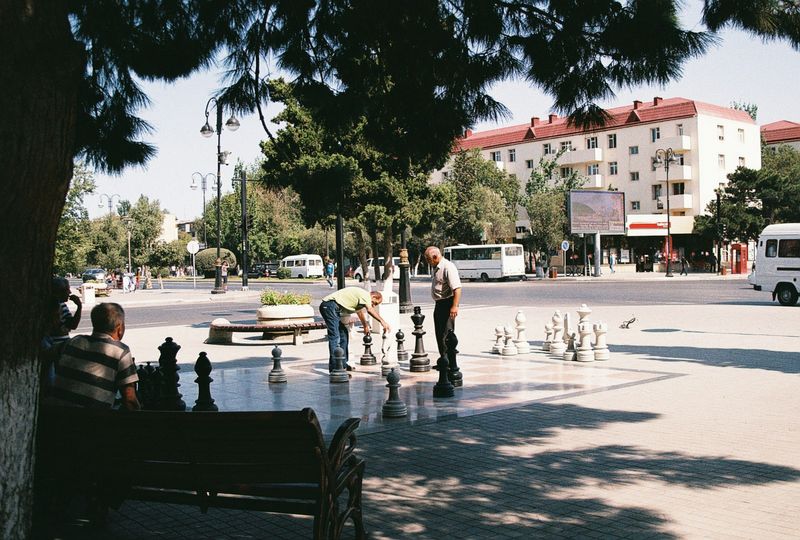Like many of its neighbouring Central Asia capital cities, such as Dushanbe and Ashgabat, Baku is a captivating blend of old-world charm and a city rushing towards modernity. Whether you’re here to visit for the history, architecture, culture, cuisine, or all of the above, the capital promises a once-in-a-lifetime Azerbaijan travel experience. Travel on an Inspiring Vacations 20 Day Azerbaijan, Georgia, Armenia & Nakhchivan tour, and you’ll get a taste of the very best this country has to offer.
Here are the must-see attractions in and beyond the capital.
6 Must-see Baku attractions
Baku blends the ancient and ultra-modern like few other cities. These six highlights offer a well-rounded look at the city’s character.
1. Baku Old City: Icherisheher
The heart of historic Baku is Icherisheher (the Inner City), also known as the Walled City of Baku. This UNESCO World Heritage Site is one of the top Azerbaijan tourist attractions, so it comes as no surprise that it is visited on day one of our exciting 20 Day Azerbaijan, Georgia, Armenia & Nakhchivan tour.
Enclosed by 12th-century defensive walls, the area contains a dense collection of narrow streets, mosques, bathhouses, and merchant houses. Notable landmarks include the Maiden Tower, a cylindrical stone structure of uncertain origin, and the Palace of the Shirvanshahs, a 15th-century royal complex featuring burial chambers, mosques, and ceremonial halls. Baku Old City is listed as one of the most important Azerbaijan UNESCO sites, recognised for its well-preserved medieval urban layout and architectural heritage.
Did you know?
Icherisheher is not just a preserved historical site—it's a vibrant, lived-in neighbourhood where daily life continues among ancient walls. Around 1,300 people still live within the Walled City of Baku, blending modern daily life with centuries-old architecture.
2. Heydar Aliyev Center
Designed by architect Zaha Hadid, the Heydar Aliyev Center is an important Azerbaijan landmark and modern Baku. The centre hosts rotating exhibitions focused on art, design, and national identity, and it serves as a venue for international events. It is one of the most prominent examples of contemporary architecture in the Caucasus region.
Did you know?
The Heydar Aliyev Center was designed without a single straight line—its fluid, wave-like form is said to reflect the evolving nature of Azerbaijani culture. Architect Zaha Hadid’s design won the 2014 Design Museum’s Design of the Year Award, making her the first woman to receive the honour.
3. Gobustan National Park
Located southwest of Baku, Gobustan National Park is known for its extensive collection of prehistoric rock carvings, some of which date back over 10,000 years. The carvings depict scenes of hunting, dancing, and ritual practices, offering insight into early human activities in the region. The park is also home to mud volcanoes, and on the exciting 20 Day Azerbaijan, Georgia, Armenia & Nakhchivan tour, you will be able to see the bubbling mud! Gobustan National Park is designated as a UNESCO World Heritage Site and is considered one of the most important historical sites in Azerbaijan.
Did you know?
Among the carvings at Gobustan National Park is one of the earliest known depictions of a boat, suggesting ancient maritime activity in the region.
4. Ateshgah Fire Temple
Situated on the outskirts of Baku, the Ateshgah Fire Temple is a religious complex associated with Zoroastrianism and Hinduism. It was constructed in the 17th century on a site where natural gas seeps created continuous flames—a phenomenon that gave Azerbaijan its nickname, ‘The Land of Fire.’ It is considered one of the most interesting Azerbaijan cultural sites.
Did you know?
The Fire Temple is one of the few places in the world where natural gas burns continuously from the ground, but similar natural gas fires can be found in other places, such as the Darvaza Gas Crater or ‘Door to Hell’ in Turkmenistan, Yanar Dag near Baku, and the Flame of the Mountain in Iran. Ateshgah stands out for its historical and spiritual significance as a site of ancient fire worship.
5. Hillside Park (Dagustu Park)
Hillside Park, also known as Dagustu Park, is a landscaped public park located on a high ridge overlooking Baku and the Caspian Sea. The park also includes Martyrs' Lane, a memorial dedicated to those who died during the Black January massacre and the Nagorno-Karabakh conflict, making it both a scenic and historically significant location.
Did you know?
Hillside Park is one of the highest points in Baku, making it a prime spot not just for history and reflection, but also for capturing some of the best photographs of the city’s skyline.
6. Yashil Bazaar (Green Market)
Yashil Bazaar is one of Baku’s central food markets and a fun spot for observing local daily life. You’ll find stallholders selling regional produce, including fresh herbs, dried fruits, nuts, cheeses, and spices. As it's predominantly a market frequented by locals, rather than tourists, you’ll get to experience Azerbaijani food culture outside of restaurants and touristy zones.
Did you know?
The name ‘Green Market’ reflects its abundance of fresh, colourful ingredients used in traditional Azerbaijani dishes.
Beyond Baku: Discover Azerbaijan UNESCO sites and more
While Baku is undoubtedly the vibrant heart of Azerbaijan, the country’s layered heritage extends far beyond its modern capital.
Shaki
Shaki is a charming city in northwestern Azerbaijan known for its blend of Silk Road history and stunning architecture. One of Sheki’s most renowned landmarks is the Sheki Khan’s Palace, a UNESCO-listed site famed for its intricate stained-glass windows and preserved frescoes. Once a summer residence for the Sheki Khans, the palace reflects the rich cultural influences of various empires, including Persian and Ottoman. Sheki's cobbled streets and picturesque landscapes further highlight its significance as a key historical and cultural hub along the ancient Silk Road.
Did you know?
Sheki is famous for its delicious Sheki baklava, a sweet pastry made from layers of filo dough, walnuts, and syrup. This local delicacy is a beloved treat that has been passed down through generations, and it is so special that it's often considered one of Azerbaijan’s national desserts.
Nakhchivan Mausoleums
The Nakhchivan Autonomous Republic, situated in the southwestern region of Azerbaijan, boasts some of the nation's most stunning historical and architectural landmarks. The Tomb of Momine Khatun is a prime example, showcasing stunning brickwork and intricate designs typical of Azerbaijani architecture. This mausoleum, along with others in the region, provides insight into the cultural heritage of Azerbaijan, blending Islamic and Persian influences. Nakhchivan’s mausoleums and tombs are key to understanding the country’s architectural evolution and its connection to ancient civilisations.
Did you know?
The Tomb of Momine Khatun’s impressive, blue-tiled dome is not only a marvel of design but also a symbol of female strength and heritage, honouring the memory of Momine Khatun, a revered historical figure.
Ganja
Known as one of the country’s oldest cities and the third largest, Ganja holds a key place in Azerbaijan’s history. Home to historical landmarks like the Javad Khan Street and the Nizami Mausoleum, Ganja is often referred to as the city of poets and thinkers, notably being the birthplace of Nizami Ganjavi, who is considered one of the greatest romantic poets in Persian literature. The city blends ancient structures with modern developments, creating a unique atmosphere that appeals to history enthusiasts. The surrounding Javad Khan Garden offers a peaceful retreat, providing a serene spot for reflection while taking in the city’s stunning landscapes.
Did you know?
Ganja was once known as the City of Seven Hills, like Rome, because of its distinctive hilltop layout. The city’s original design, with its strategic placement on elevated ground, allowed it to serve as a vital military and cultural centre in ancient times.
Azerbaijan travel practical tips: things you need to know
Here are some practical tips to help you navigate local customs, transport, and daily essentials with ease when touring Azerbaijan.
-
Currency and payments
Azerbaijan’s official currency is the Azerbaijani manat (AZN). Major credit cards are accepted in hotels, restaurants, and larger shops in Baku, but if you’re travelling to rural areas, it's a good idea to have cash with you. ATMs are readily available, but it’s advisable to withdraw cash in larger cities like Baku or Ganja before travelling to more remote areas.
-
Language
The official language of Azerbaijan is Azerbaijani. While Russian is still commonly spoken, particularly in larger cities, English is not as widely spoken outside tourist areas. It's helpful to learn a few basic Azerbaijani phrases like Salam (hello) and download a translation app before flying.
-
Getting around
Azerbaijan has a well-developed public transport network, including buses, a metro in Baku, and taxis. Baku’s metro system is clean and efficient for getting around the capital. Taxis can be flagged down on the street, but remember to agree on the fare in advance. If you don't want the hassle, ride-sharing apps Bolt and Yandex Go are local alternatives to Uber – both link to a credit card (or you can pay cash) and have an English language interface.
-
Dress code
Although Azerbaijan is a secular country, dressing modestly is appreciated, particularly when visiting religious sites. For women, covering the shoulders and knees is considered a respectful practice. The dress code in Baku is generally more relaxed, especially in places like restaurants, cafes, and shopping malls.
-
Cuisine
Azerbaijani cuisine is diverse and delicious, featuring a mix of Middle Eastern, Central Asian, and Caucasian influences. Plov (pilaf) and kebabs are some popular dishes to try, and there are plenty of colourful dishes for vegetarians. It’s best to stick with bottled water rather than tap water, which is widely available. Alcohol is not prohibited, and alcoholic drinks can be bought in most supermarkets and ordered at restaurants.
Inspired to visit Azerbaijan? Our 20 Day Azerbaijan, Georgia, Armenia & Nakhchivan takes in the highlights of Azerbaijan as well as Tbilisi in Georgia, Yerevan in Armenia and Nakhchivan. Check out Inspiring Vacations for more tours.
